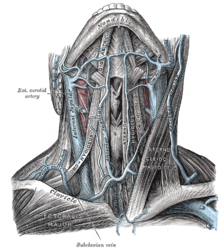Jugular vein thrombosis
| Classification according to ICD-10 | |
|---|---|
| I82.8 | Embolism and thrombosis of other specified veins |
| ICD-10 online (WHO version 2019) | |
Under a jugular vein thrombosis refers to the rare, usually unilateral thrombotic occlusion of the large jugular vein ( jugular vein ), usually the internal jugular vein .
Spread and causes

In the pre-antibiotic period, the most common cause of jugular vein thrombosis was bacterial inflammation in the head and neck area, such as neck phlegmon , peritonsillar abscess , Lemierre's syndrome or mastoiditis . Today, jugular vein thrombosis occurs as a rare complication of a central venous catheter introduced through the jugular vein or after extensive neck surgery. Also intravenous drug abuse with injection into the jugular veins, a blunt neck trauma or coagulopathy are a possible cause. Jugular vein thrombosis is more frequently found paraneoplastically in cancer of the pancreas , bronchial , stomach or ovaries .
Clinical manifestations
The clinical picture is different. A high feverish course with unilateral painful swelling and relieving posture of the neck, possibly swallowing and voice disorders, pressure sensitivity of the vascular cord and subsequent sepsis is rather rare today. There are more unspecific signs with a swelling of the neck, headache, enlarged neck lymph nodes. In the course of the vein, a coarse cord can be felt and a positive Queckenstedt sign can be found. A jugular vein thrombosis is often found incidentally in a symptom-free patient as part of a sonographic examination.
Investigation methods
In addition to the physical examination, sonography is the method of choice. Other imaging methods such as computed tomography or magnetic resonance tomography also reliably lead to a diagnosis. Laboratory chemistry shows an increase in D-dimers , and increased infection parameters (increased C-reactive protein , leukocytosis ) are also possible.
treatment
Treatment with heparin is causal , and antibiotics are given to avoid sepsis. Intraluminal lysis therapy is usually not performed because of the risk of developing sepsis. Basically, the underlying disease needs to be treated. Surgical ligature or resection of the internal jugular vein is required if sepsis is threatened or just beginning .
Individual evidence
- ↑ a b c C. C. Boedecker et al: Etiology and management of thromboses of the internal jugular vein. In: Laryngo-Rhino-Otol. 2004; 83, pp. 743-749.
- ↑ J. Stern-Sträter et al.: Jugular vein thrombosis as a paraneoplastic syndrome. In: ENT. 2008; 56, pp. 325-327.
- ↑ Jugular vein thrombosis. In: Roche Lexicon Medicine. 5th edition. Elsevier, Urban & Fischer Verlag, Munich / Jena 2003, ISBN 3-437-15072-3 . (Online version)
- ↑ Jugular vein thrombosis - a malignant disease can also be the cause. In: Doctors newspaper . September 29, 2008.